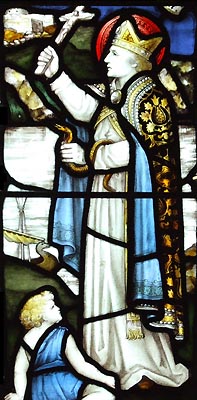 |
 |
|||
|
|
Carannog was one of the saintly sons of Prince Corun of Ceredigion, a son - probably the eldest - of the founding King Ceredig Ceredigion. The Kingdom of Ceredig, being invaded by the Irish and the King being advanced in years and infirm, the nobles counselled him to abdicate in favour of his eldest grandson, Carannog (presumably Corun at predeceased them both). The young prince, however, was more devoted to God than to his own kingdom and fled such an honour disguised as a beggar in order to live as a hermit in a cave at Edilu, amongst the coastal rocks (or on the hillside) near Gweryd Carannog (Llangrannog) in Ceredigion. Here he gave his time to prayer and to the study of the scriptures. He shaped himself a staff with his knife and a dove appeared and carried off the shavings. Carannog followed the dove through the woods to a clearing. Where the bird had collected the wood, the saint built Llangrannog Church. After a time, Carannog decided to travel as a missionary. He may have gone first to Kernow (Cornwall) where he founded the church at Langorroc (Crantock) near Newquay. The Irish certainly thought he was a Cornishman when he arrived to convert the people of Leinster. He was known as Cairnech of Tuilen (Dulane in Co. Meath) in Ireland and is said to have been associated with St. Patrick in the country’s evangelisation, although this is chronologically impossible. He healed the blind, the lame and the insane and there are many churches and places named after him in Leinster. Not surprisingly, Carannog came into contact with King Dunlang of Leinster. The King had a fine (perhaps sacred) tree which Carannog asked if he could have. The monarch refused but, not long afterwards, it blew down in a storm and so was to the saint. Carannog reserved the wood to build himself a church and commissioned a well-known architect for the job. However, it being a chilly winter, he gave away some of it to some visitors in need of a fire. The architect was furious, but through his prayers, Carnnog restored the missing wood. It was around this time that a thirteen-year-old Irish prince named Tenenan (or Ternog) came to be educated by Carannog. When he grew up, he travelled to the Royal British Court (probably of King Arthur). However, he was so pestered by the ladies that he prayed for leprosy to scare his handsome face. Everything happened as he wished and Tenenan returned to Carannog. The Welsh saint bathed him and the leprosy was cured. Tenenan insisted that Carannog bathe after him, thus revealing that his teacher wore seven heavy iron belts around his waist as a penitent sinner. Tenenan then departed for Brittany where he founded a number of churches in honour of Carannog. Carannog eventually returned to Wales and again occupied, for a short time, the same cave which had formerly been his hermitage. He was joined by a number of brethren, and this may have made him eager to depart for a solitary life elsewhere. Like most holy men of the time, Carannog had a small portable stone altar. So, desiring to cross the Bristol Channel to Somerset, he threw this into the sea. When it miraculously floated, he was able to use it as a small boat and pass safely over to the West Country. However, somehow the two became separated and Carannog landed near Dindraithou (Dunster), the home of King Cado of Dumnonia, without his altar. He made his way to Carrum (Carhampton) where he made enquiries as to where it had come ashore. The High-King Arthur was staying in the region at the time, undertaking the challenge of defeating a ferocious dragon which was ravaging the local countryside. Arthur’s men had found the altar at the mouth of the River Guellit (Willett) and had tried to use it as a table, but everything that was placed upon it was immediately thrown off. Arthur agreed to meet with Carannog, but he refused to return the altar unless the saint rid the landscape of the fearsome dragon. So Carannog prayed for the beast to come to him and - so it did, like a servant obeying his master. The saint placed his stole round its neck and led it into the great hall at Dindraithou, where it was presented to King Cado. The King’s men wished to kill the beast, but Carannog explained that it had only eaten sinners and sent it away instead. (The legend of the dragon and St. Carannog has also been transferred to Brittany, although he never seems to have visited the region.) In return, Carannog received not only his altar, but a grant of the village of Carrum, where he subsequently built a famous monastery. This remained into post-reformation times as a small ruined chapel in the parish. Eventually, Carannog returned to Ireland and there he died on 16th May and was buried at Inis-Baithen in Leinster or Tuilen (Dulane) in Meath. Carannog alias Cairnech should not be confused with St. Cairnech of Drumleen, another 6th century Irish missionary whose feast day is 28th March. There may also have been two further saints of this name since two alternative ancestries exist. Records of St. Carannog date back to the 13th century. He could be historic.
|
|||
| © Nash Ford Publishing 2006. All Rights Reserved. | ||||





 St. Carannog
St. Carannog